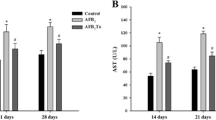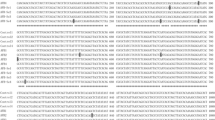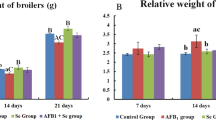Abstract
The aim of the study was to investigate the effect of selenium on hepatic mitochondrial antioxidant capacity in ducklings administrated with aflatoxin B1 (AFB1). Ninety 7-day-old ducklings were randomly divided into three groups (groups I–III). Group I was used as a blank control. Group II was administered with AFB1 (0.1 mg/kg body weight). Group III was administered with AFB1 (0.1 mg/kg body weight) plus selenium (sodium selenite, 1 mg/kg body weight). All treatments were given once daily for 21 days. The results showed that the activities of mitochondrial superoxide dismutase (SOD), catalase (CAT), glutathione peroxidase (GSH-Px), and glutathione reductase (GR) in group II ducklings significantly decreased when compared with group I (P < 0.01). Furthermore, the content of hepatic mitochondrial malondialdehyde (MDA) significantly increased (P < 0.01). However, the activities of hepatic mitochondrial SOD, CAT, GSH-Px, and GR in group III ducklings significantly increased when compared with group II (P < 0.05). In addition, the content of hepatic mitochondrial MDA significantly decreased (P < 0.01). These results revealed that AFB1 significantly induced hepatic mitochondrial antioxidant dysfunction. However, sodium selenite could significantly ameliorate the negative effect induced by AFB1.
Similar content being viewed by others
Avoid common mistakes on your manuscript.
Introduction
Aflatoxins, a group of extremely toxic and biologically active substances, are produced by the fungi Aspergillus flavus and Aspergillus parasiticus. Among them, aflatoxin B1 (AFB1) is a matter of concern due to their widespread contamination of cereal grain commodities, corn in particular, and their adverse effects on human and animal health. Aflatoxin B1 is produced by toxigenic fungi belonging to the genus Aspergillus and has a long history of association with illness in domesticated animals and in humans [1, 2]. The liver is especially sensitive to AFB1. The AFB1 is firstly a hepatotoxin, causing an excessive buildup of hepatic lipids, with enlargement of the liver, proliferation of the biliary ducts [3], and hepatocellular carcinoma [4].
To date, the mechanisms underlying the AFB1-induced cytotoxicity have not been fully clarified. It was considered that AFB1-mediated cell injury may be due to the release of free radicals, which initiate lipid peroxidation [5]. Recently, the direct evidence of the involvement of free radicals in AFB1 toxicity was demonstrated by Towner [6], who identified free radicals in vivo in rat bile following AFB1 administration. It is known that oxidative stress can play an important role in the initiation of carcinogenesis through DNA damage [7]. This may be one of the mechanisms responsible for AFB1-induced carcinogenesis. In a number of studies, the ability of antioxidants to defend chemical carcinogenesis when administered prior to or concomitantly with the carcinogen was demonstrated [8]. AFB1-mediated hepatic lipid peroxidation and serum activity of transaminases were reduced by the pretreatment of rats with antioxidants, selenium, and vitamin E [5]. The present study was designed to assess the effect of selenium on hepatic mitochondrial antioxidant capacity in ducklings administered with AFB1.
Materials and Methods
Drugs and Chemicals
Aflatoxin B1, d-Mannitol, hydroxyethyl piperazine ethanesulfonic acid (HEPES), ethylene glycol tetraacetate (EGTA), sucrose, bovine serum albumin (BSA), dimethyl sulfoxide, coomassie brilliant blue, and rotenone were purchased from Sigma. Detection kit which includes superoxide dismutase, catalase, glutathione peroxidase, glutathione reductase, and malondialdehyde were purchased from Nanjing Jiancheng Bioengineering Institute. All other chemicals were of analytical grade.
Animals and Treatments
All experimental protocols were approved by the Ethics Committee of South China Agricultural University. This study was carried out on 90 Guangdong white ducklings weighing 180–200 g body weight. Seven-day-old ducklings were obtained from the Research Center of Experimental Animals at South China Agricultural University. The animals were randomly divided into three equal groups containing 30 ducklings with an equal number of male and female ducklings. Group I was used as control and intragastrically administered with dimethyl sulfoxide (DMSO). Group II was intragastrically administered with AFB1 (0.1 mg/kg body weight). Group III was intragastrically administered with AFB1 (0.1 mg/kg body weight) plus selenium (sodium selenite, 1 mg/kg body weight). These treatments were administrated once daily for a period of 21 days under the same condition. AFB1 was diluted with DMSO for experimental groups. All ducklings had free access to water and food at room temperature during the study.
Mitochondrial Preparation
Mitochondria were isolated from the duckling liver by differential centrifugation as described by Tang [9], with modifications. On 7th, 14th, and 21st day after treatment, five ducklings were randomly taken out to obtain respectively about 15 g of liver in every experimental group. The liver was trimmed of fat and washed in ice-cold initial liver mitochondria isolation medium A (220 mM d-Mannitol, 70 mM sucrose, 2 mM HEPES, 1 mM EGTA, and 0.5 mg/mL BSA, adjusted to pH 7.0 with Tris). The liver was then weighed, minced, and transferred to a 50-mL capacity Potter homogenizer run at 2,000 rpm (0.15 mm radial pestle clearance) for 3 min. The homogenate was diluted to 300 mL using medium A (6 × 50 mL) and centrifuged for 10 min at 1,000×g. The supernatant was filtered through a four-layer cheesecloth and centrifuged again at 1,000×g for 10 min. After the supernatant was centrifuged at 10,000×g for 14 min, the pellet was suspended in 100 mL (2 × 50 mL) medium B, a second liver mitochondria isolation medium (220 mM d-Mannitol, 70 mM sucrose, 2 mM HEPES, and 0.5 mg/mL BSA, adjusted to pH 7.0 with Tris), and centrifuged for 10 min at 10,000×g. The resulting pellet was resuspended in liver mitochondria incubation medium C (220 mM d-Mannitol, 70 mM sucrose, and 2 mM HEPES, adjusted to pH 7.0 with Tris). All the steps are strictly operated on ice to guarantee the isolation of high-quality mitochondrial preparation. The protein concentration of the final mitochondrial pellet was determined with the Bradford’s assay using bovine serum albumin as a protein standard [10].
Assessment of Mitochondrial Antioxidant Capacity
The activities of mitochondrial superoxide dismutase, catalase, glutathione peroxidase, and glutathione reductase were detected, according to instruction in the detection kit. Similarly, the content of mitochondrial malondialdehyde was detected. The activities of mitochondrial superoxide dismutase, catalase, glutathione peroxidase, and glutathione reductase are expressed as international units per milligram mitochondrial protein. The content of mitochondrial malondialdehyde is expressed as nanomol per milligram mitochondrial protein.
Statistical Analysis
The statistical significance of differences between groups in these studies was determined using a one-way analysis of variance and the results were presented as the mean ± S.E. The significance level was P < 0.05.
Results and Analysis
Hepatic Mitochondrial Superoxide Dismutase Activity
As shown in Table 1, the activity of hepatic mitochondria superoxide dismutase (SOD) was significantly affected after the ducklings were intragastrically administered with AFB1 for 7, 14, and 21 days (P < 0.01). The activity of SOD decreased by 20.97%, 27.38%, and 34.89%, respectively. However, in group III ducklings intragastrically administered with AFB1 plus selenium, the activity of SOD increased by 17.86%, 20.92%, and 31.44% respectively, compared with group II (P < 0.01).
Hepatic Mitochondrial Catalase Activity
As summarized in Table 2, the activity of hepatic mitochondria catalase (CAT) was significantly affected after ducklings were intragastrically administered with AFB1 for 7, 14, and 21 days (P < 0.01). The activity of CAT decreased by 26.16%, 31.91%, and 40.28%, respectively. However, in group III ducklings intragastrically administered with AFB1 plus selenium, the activity of CAT increased by 21.96%, 25.99%, and 30.50% respectively, compared with group II (P < 0.01).
Hepatic Mitochondrial Glutathione Peroxidase Activity
As shown in Table 3, the activity of hepatic mitochondria glutathione peroxidase (GSH-Px) was significantly affected after ducklings were intragastrically administered with AFB1 for 7, 14, and 21 days (P < 0.01). The activity of GSH-Px decreased by 25.81%, 29.08%, and 33.25%, respectively. However, in group III ducklings intragastrically administered with AFB1 plus selenium, the activity of GSH-Px increased by 16.79%, 19.29%, and 20.36% respectively, compared with group II (P < 0.05).
Hepatic Mitochondrial Glutathione Reductase Activity
As summarized in Table 4, the activity of hepatic mitochondria glutathione reductase (GR) was significantly affected after ducklings were intragastrically administered with AFB1 for 7, 14, and 21 days (P < 0.01). The activity of GR decreased by 20.92%, 24.49%, and 33.02%, respectively. However, in group III ducklings intragastrically administered with AFB1 plus selenium, the activity of GR increased by 13.52%, 20.24%, and 23.66% respectively, compared with group II (P < 0.05).
Hepatic Mitochondrial Malondialdehyde Content
As shown in Table 5, the content of hepatic mitochondria malondialdehyde (MDA) was significantly affected after ducklings were intragastrically administered with AFB1 for 7, 14, and 21 days (P < 0.01). The content of MDA increased by 42.31%, 210.00% and 250.91% respectively. However, in group III ducklings intragastrically administered with AFB1 plus selenium, the content of MDA decreased by 25.64%, 45.81%, and 42.49% respectively, compared with group II (P < 0.01).
Discussion
Aflatoxins are secondary toxic fungal metabolites produced by A. flavus and A. parasiticus. There are four naturally occurring aflatoxins, the most hepatotoxic being AFB1, and three structurally similar compounds, namely aflatoxin B2, aflatoxin G1, and aflatoxin G2. It is well known that AFB1 may induce the production of free radicals and/or the reduction of antioxidant defenses [11, 12]. In animal organism, reactive oxygen metabolites (ROM) include intracellular thiols (SH), MDA. The MDA production is recognized as an important factor in determining alteration of membrane fluidity [13, 14] and increase of membrane fragility accompanying final cell death [15]. The ROM content in animal cells may be increased by several factors, including metabolism of xenobiotics, such as the mycotoxins, with the onset of oxidative stress conditions as a result [16]. Several authors [17–19] reported that some mycotoxins can cause cell membrane damage through the increase of lipid peroxidation. Moreover, results of those studies indicate the important role of the ROM production in explaining the cytotoxic and, possibly, genotoxic potential of the mycotoxins. In continuation of these studies, we investigated the effect of AFB1 on ducklings’ hepatic mitochondrial antioxidant capacity in this research. For 7, 14, and 21 days after ducklings administrated with AFB1 respectively, the results showed that the activities of mitochondrial SOD, CAT, GSH-Px, and GR in group II ducklings (administered with AFB1) significantly decreased when compared with group I (P < 0.01). Furthermore, the content of hepatic mitochondrial MDA in group II significantly increased (P < 0.01).
Although the mechanism underlying the hepatotoxicity of aflatoxins is not fully understood, several reports suggest that toxicity may ensue through the generation of intracellular reactive oxygen species like superoxide anion, hydroxyl radical, and hydrogen peroxide during the metabolic processing of AFB1 by cytochrome P450 in the liver [20]. These species may attack soluble cell compounds as well as membranes, eventually leading to the impairment of cell functioning and cytolysis [21, 22]. But peroxidative damages induced in the cell are encountered by elaborate defense mechanisms, including enzymic and nonenzymic antioxidants. AFB1-mediated hepatic lipid peroxidation and serum activity of transaminases were reduced by the pretreatment of rats with antioxidants, selenium, and vitamin E. The defense mechanisms can be reinforced by increasing dietary intake of antioxidants and micronutrients such as vitamin E and selenium (Se). The importance of Se is linked to by its role as a constituent of several enzymes of the physiological antioxidative system, as well as enzymes such as thioredoxin reductase, whose chief function is to facilitate electron transport. The reduction of reactive oxygen metabolites by glutathione peroxidases helps to maintain membrane integrity [23]. In this study, we assessed the effect of selenium on hepatic mitochondrial antioxidant function in ducklings administrated with AFB1. For 7, 14, and 21 days after ducklings administrated with AFB1 respectively, it showed that the activities of hepatic mitochondrial SOD, CAT, GSH-Px, and GR in group III ducklings (administered with AFB1 plus sodium selenite) significantly increased when compared with group II (P < 0.05). In addition, the content of hepatic mitochondrial MDA in group III significantly decreased (P < 0.01). The results of the present study demonstrate that sodium selenite significantly ameliorates the negative effect of AFB1 on hepatic mitochondrial antioxidant capacity in ducklings.
References
Wogan GN (1999) Aflatoxin as a human carcinogen. Hepatology 30:217–221
Bondy GS, Pestka JJ (2000) Immunomodulation by fungal toxins. J Toxicol Environ Health B Crit Rev 3:109–143
Adav SS, Godinwar SP (1997) Effects of aflatoxin B1 on liver microsomal enzymes in different strains of chickens. Comp Biochem Physiol C Pharmacol Toxicol Endocrinol 118:185–189
Hamilton PB (1978) Fallacies in our understanding of mycotoxins. J Food Prot 41:404–408
Shen HM, Shi CY, Lee HP, Ong CN (1994) Aflatoxin B1-induced lipid peroxidation in rat liver. Toxicol Appl Pharmacol 127:145–150
Towner RA, Qian SY, Kadiiska MB, Mason RP (2003) In vivo identification of aflatoxin-induced free radicals in rat bile. Free Radic Biol Med 35:1330–1340
Visioli F, Grande S, Bogani P, Galli C (2004) The role of antioxidants in the mediterranean diets: focus on cancer. Eur J Cancer Prev 13:337–343
Yu SY, Chu YJ, Li WG (1988) Selenium chemoprevention of liver cancer in animals and possible human applications. Biol Trace Elem Res 15:231–241
Tang Z, Iqbal M, Cawthon D, Bottje WG (2002) Heart and breast muscle mitochondrial dysfunction in pulmonary hypertension syndrome in broilers (Gallus domesticus). Comp Biochem Physiol A Mol Integr Physiol 132:527–540
Bradford HF, Dodd PR (1977) Convulsions and activation of epileptic foci induced by monosodium glutamate and related compounds. Biochem Pharmacol 26:253–254
Shen HM, Shi CY, Shen Y, Ong CN (1996) Detection of elevated reactive oxygen species level in cultured rat hepatocytes treated with aflatoxin B1. Free Radic Biol Med 21:139–146
Leal M, Shimada A, Ruíz F, González de Mejía E (1999) Effect of lycopene on lipid peroxidation and glutathione-dependent enzymes induced by T-2 toxin in vivo. Toxicol Lett 109:1–10
Chen JJ, Yu BP (1994) Alterations in mitochondrial membrane fluidity by lipid peroxidation products. Free Radic Biol Med 17:411–418
Ferrante MC, Meli R, Mattace Raso G, Esposito E, Severino L, Di Carlo G, Lucisano A (2002) Effect of fumonisin B1 on structure and function of macrophage plasma membrane. Toxicol Lett 129:181–187
Halliwell B, Chirico S (1993) Lipid peroxidation: its mechanism, measurement, and significance. Am J Clin Nutr 57(5 Suppl):715S–724S, discussion 724S-725S
Klaunig JE, Xu Y, Isenberg JS, Bachowski S, Kolaja KL, Jiang J, Stevenson DE, Walborg EF Jr (1998) The role of oxidative stress in chemical carcinogenesis. Environ Health Perspect 106(Suppl 1):289–295
Abado-Becognee K, Mobio TA, Ennamany R, Fleurat-Lessard F, Shier WT, Badria F, Creppy EE (1998) Cytotoxicity of fumonisin B1: implication of lipid peroxidation and inhibition of protein and DNA syntheses. Arch Toxicol 72:233–236
Yin JJ, Smith MJ, Eppley RM, Page SW, Sphon JA (1998) Effects of fumonisin B1 on lipid peroxidation in membranes. Biochim Biophys Acta 1371:134–142
Abel S, Gelderblom WC (1998) Oxidative damage and fumonisin B1-induced toxicity in primary rat hepatocytes and rat liver in vivo. Toxicology 131:121–131
Sohn DH, Kim YC, Oh SH, Park EJ, Li X, Lee BH (2003) Hepatoprotective and free radical scavenging effects of Nelumbo nucifera. Phytomedicine 10:165–169
Błaszczyk I, Grucka-Mamczar E, Kasperczyk S, Birkner E (2010) Influence of methionine upon the activity of antioxidative enzymes in the kidney of rats exposed to sodium fluoride. Biol Trace Elem Res 133:60–70
Berg D, Youdim MB, Riederer P (2004) Redox imbalance. Cell Tissue Res 318:201–213
Brenneisen P, Steinbrenner H, Sies H (2005) Selenium, oxidative stress, and health aspects. Mol Aspects Med 26:256–267
Acknowledgments
This work was supported by the National Natural Science Foundation of China (Grant No. 38071900).
Author information
Authors and Affiliations
Corresponding author
Additional information
Dayou Shi, Shining Guo, and Shenquan Liao contributed equally to this work.
Rights and permissions
About this article
Cite this article
Shi, D., Guo, S., Liao, S. et al. Influence of Selenium on Hepatic Mitochondrial Antioxidant Capacity in Ducklings Intoxicated with Aflatoxin B1 . Biol Trace Elem Res 145, 325–329 (2012). https://doi.org/10.1007/s12011-011-9201-z
Received:
Accepted:
Published:
Issue Date:
DOI: https://doi.org/10.1007/s12011-011-9201-z




